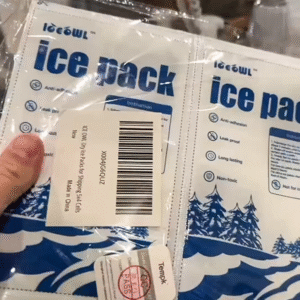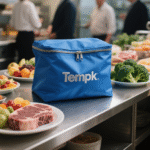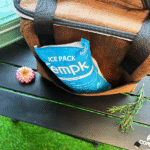Packs de glace sèche de camping: Your Ultimate Guide to Extended Freshness
Planning a camping trip and wondering how to keep your food fresh without the hassle of melting ice? Dry ice packs might be the solution you’re looking for. These solid carbon dioxide packs offer a colder alternative to traditional ice, ensuring your perishables stay frozen longer. Dans ce guide, nous explorerons les avantages, Précautions de sécurité, and best practices for using dry ice packs during your outdoor adventures.

Pourquoi choisir Packs de glace carbonique pour le camping?
Dry ice packs offer several advantages over traditional ice that can improve your camping experience. They are cold enough to maintain freezing temperatures for several days, which is perfect for keeping perishable items like meat, fruit de mer, and frozen meals safe for extended trips. Since they sublimate directly from solid to gas, there’s no mess or water residue to worry about, making dry ice an incredibly efficient cooling method.
Le main benefits of camping with dry ice packs include:
-
Durée de refroidissement prolongée: Dry ice can keep your food frozen for 2-3 jours, much longer than regular ice.
-
Pas de gâchis: Contrairement à la glace ordinaire, dry ice sublimates and doesn’t leave behind a puddle of water, so your food and cooler stay dry.
-
Efficacité de l'espace: Dry ice takes up less space than traditional ice, allowing you to fit more items into your cooler.
-
Maintaining freshness: The ultra-low temperatures of dry ice help preserve food and prevent spoilage, keeping everything fresh longer.
Que sont les packs de glace sèche?
Dry ice packs are solid blocks or sheets of CO₂ that sublimate directly from a solid to a gas at temperatures as low as −78.5°C (−109,3 ° F). This makes them much colder than regular ice, which is solid water at 0°C. Because dry ice sublimates into gas instead of melting into water, it ensures that your cooler and food stay dry, preventing sogginess, and keeping items that require freezing frozen for a longer period.
How Do Camping Dry Ice Packs Compare to Traditional Ice?
To understand whether dry ice is the right choice for your trip, let’s compare it to traditional ice and other cooling methods. Here’s a side-by-side breakdown:
| Méthode de refroidissement | Plage de température | Durée de refroidissement | Désordre | Meilleurs cas d'utilisation | Ce que cela signifie pour vous |
|---|---|---|---|---|---|
| Packs de glace sec | −78,5 ° C (Limères soudantes) | 2-3 jours ou plus | Aucun (Sublimer le gaz) | Long adventures, articles surgelés | Keeps food frozen without water, ideal for long trips with meats or ice cream. |
| Glace ordinaire | 0°C (Fond dans l'eau) | 12-24 heures | Haut (Fond dans l'eau) | Courts déplacements, boisson, articles réfrigérés | Suitable for overnight or day trips but creates a mess and doesn’t keep food frozen. |
| Packs de gel | ~0°C to 5°C | 12-36 heures | Moyen (Some condensation) | Produits frais, boissons, laitier | Good for keeping things cool, not for freezing. |
| Matériau à changement de phase (PCM) Packs | 0°C à −20°C (Tunable) | 2-4 jours | Minimal | Hybrid solutions for both chilled and frozen | Provides controlled temperature for mixed items. |
Dry ice packs are perfect for keeping food completely frozen pour de longues périodes, Contrairement à la glace ordinaire, which only chills items for a limited time.
How to Safely Use Dry Ice Packs While Camping
Using dry ice requires a few precautions to ensure both effectiveness and safety. Here’s how to make the most of your dry ice packs:
-
Utiliser un équipement de protection
Manipulez toujours la glace carbonique avec des gants ou des pinces pour éviter les engelures. -
La ventilation est la clé
Depuis la glace sèche sublime dans le dioxyde de carbone (Co₂) gaz, ensure your cooler has proper ventilation to allow the gas to escape. This prevents dangerous CO₂ buildup, ce qui peut provoquer la suffocation. -
Pack Your Cooler Efficiently
-
Place dry ice at the bas of your cooler for even cooling, ensuring that food closest to the dry ice stays frozen.
-
Fill any empty spaces in the cooler with insulation like crumpled newspaper, serviettes, or additional dry ice to reduce air gaps, which increase sublimation.
-
Wrap dry ice with paper or use a dry ice pack sleeve to prevent direct contact with food, which can lead to freezer burns.
-
-
Leave Space for CO₂ Gas to Escape
Ensure there is some space for CO₂ gas to escape to avoid pressure buildup, which could damage your cooler. -
Surveiller la température
For items that need to stay below freezing, use a thermometer to check the internal cooler temperature regularly.
How to Choose the Right Camping Dry Ice Packs for Your Trip?
Selecting the correct dry ice packs for your camping trip depends on several factors including the duration of your trip, the type of cooler you’re using, and the nature of the food you plan to store.
Pour les déplacements courts, a small cooler may only need 1-2 livres de glace carbonique, whereas longer trips may require larger blocks or more dry ice to maintain optimal freezing temperatures. Here’s how to plan for your needs:
-
Voyages de week-end (1-2 jours): 2-4 livres de glace carbonique.
-
Voyages prolongés (3-5 jours): 10-20 livres de glace carbonique.
-
Long expeditions (5+ jours): 25-50 livres de glace carbonique, plus regular ice for extra cooling.
Conseil: For trips in warm climates or high altitudes where sublimation rates are faster, always bring extra dry ice.
Latest Trends in Camping Dry Ice Packs for 2025
À mesure que la technologie progresse, there are several exciting trends in camping dry ice packs that are making outdoor refrigeration even more efficient and sustainable.
-
Innovations respectueuses de l'environnement: Biodegradable coolers and recyclable packaging are emerging to make dry ice products more sustainable.
-
Refroidisseurs intelligents: Coolers with integrated temperature sensors, Bluetooth connectivity, and mobile app monitoring allow campers to track their cooler’s internal temperature in real-time.
-
Solutions de refroidissement hybrides: Combining dry ice with Phase Change Materials (PCMS) or gel packs offers a flexible solution for controlling temperatures over extended periods.
These innovations are making it easier to keep your food fresh while reducing environmental impact and improving convenience.
Questions fréquemment posées (FAQ)
Q1: How do camping dry ice packs compare to traditional ice?
Camping dry ice packs offer longer-lasting cooling, prevent water residue, and are more compact than traditional ice, making them ideal for extended trips in remote locations.
Q2: Combien de temps dure la glace sèche dans une glacière?
La glace carbonique peut durer entre 24-48 heures, depending on the size of the pack and the insulation of your cooler. Pour des voyages plus longs, multiple dry ice packs may be necessary.
Q3: Can I use dry ice for short camping trips?
Oui, dry ice is perfect for short camping trips where you need efficient, long-lasting cooling without the mess of melting ice.
Conclusion
Camping dry ice packs are an excellent solution for keeping your food and beverages cool during outdoor adventures. Whether you’re going for a weekend getaway or an extended trip, dry ice packs can keep your food fresh and prevent spoilage, all while being more space-efficient than traditional ice. By choosing the right dry ice pack and using it correctly, you can enhance your camping experience and enjoy fresh meals and drinks throughout your trip.
À propos du tempk
Tempk is a trusted provider of cold-chain solutions, offering high-performance dry ice packs, PCM refrigerants, et conteneurs isothermes. En mettant l’accent sur la durabilité et l’innovation, we design products that are reusable, écologique, and tailored for camping and outdoor use.























